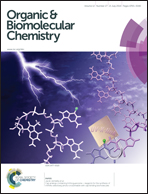N[1,3]-sigmatropic shift in the benzidine rearrangement: experimental and theoretical investigation†
Abstract
The N[1,3]-sigmatropic shift in the benzidine rearrangement has been studied in depth experimentally with the aid of density functional theory (DFT) calculations. The designed substituted N,N′-diaryl hydrazines rearrange exclusively to the expected o/p-semidines and diphenylines. Intercrossing experiments support the intramolecular rearrangement process. Radical trapping experiments exclude the intermediacy of biradicals in the rearrangements. Computational results demonstrate that the o-semidine rearrangement involves a novel N[1,3]-sigmatropic shift and the p-semidine rearrangement proceeds via tandem N[1,3]/N[1,3]-sigmatropic shifts, while the diphenyline rearrangement occurs through cascade N[1,3]/[3,3]-sigmatropic shifts. The proposed mechanism involving the key N[1,3]-sigmatropic shift as the rate-limiting step is in good agreement with reported kinetic isotope measurements. The combined methods provide new insight into the formation mechanism of o/p-semidines and diphenylines in the benzidine rearrangement and support the unprecedented suprafacial symmetry allowed N[1,3]-sigmatropic shift with an inversion of the configuration in the migrating nitrogen atom.
![Graphical abstract: N[1,3]-sigmatropic shift in the benzidine rearrangement: experimental and theoretical investigation](/en/Image/Get?imageInfo.ImageType=GA&imageInfo.ImageIdentifier.ManuscriptID=C4OB00080C&imageInfo.ImageIdentifier.Year=2014)

 Please wait while we load your content...
Please wait while we load your content...